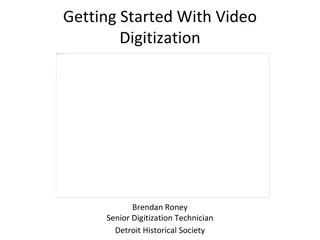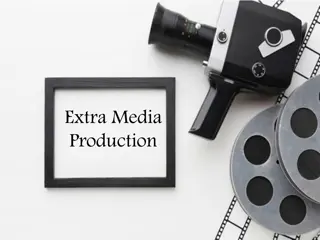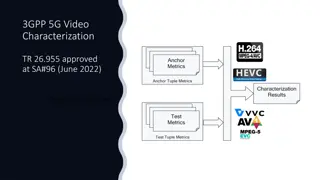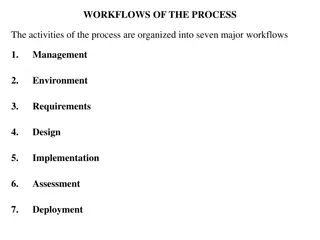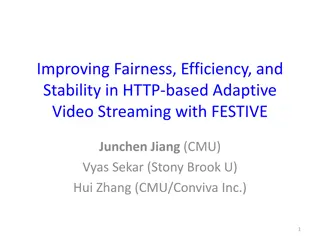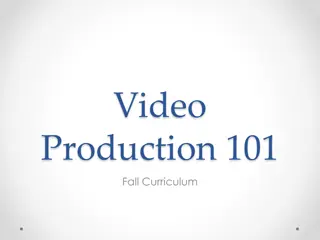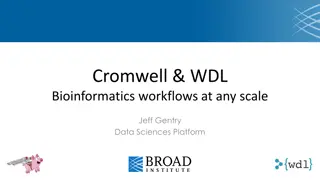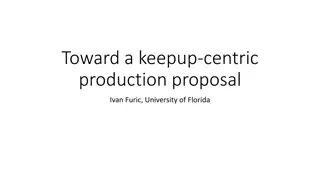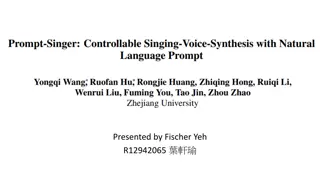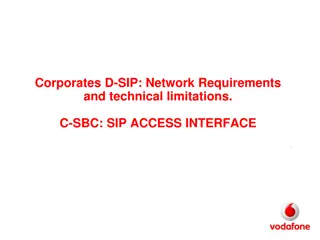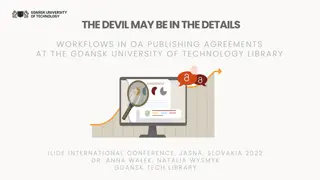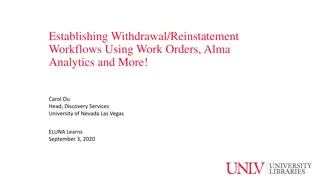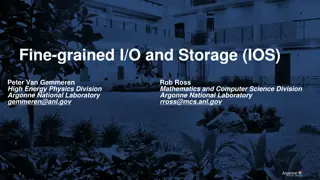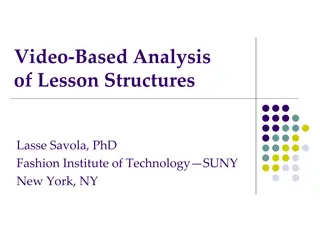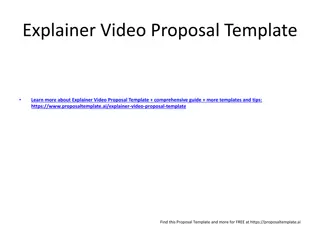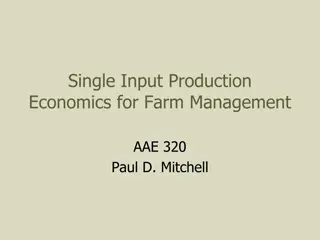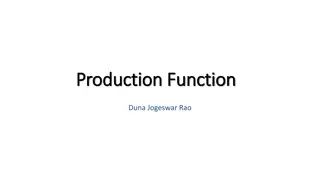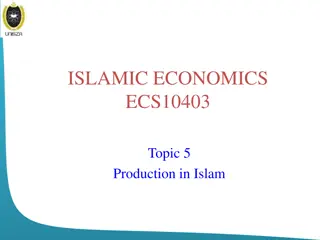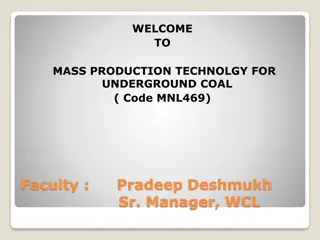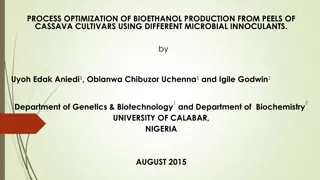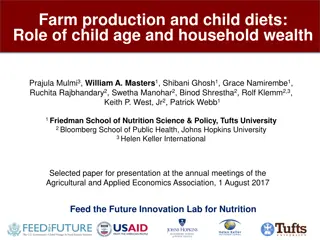Understanding Video Codecs and Workflows in Production
Explore key concepts in video codec production and post-production workflows. Learn about high-level concepts, consumer distribution considerations, and production/post workflows for optimal image quality. Understand the importance of compression, storage, and decoding processes in creating and delivering video content effectively.
Download Presentation

Please find below an Image/Link to download the presentation.
The content on the website is provided AS IS for your information and personal use only. It may not be sold, licensed, or shared on other websites without obtaining consent from the author. Download presentation by click this link. If you encounter any issues during the download, it is possible that the publisher has removed the file from their server.
E N D
Presentation Transcript
Video Codecs for Production and Post- Production Edward Reuss Co-chair SMPTE Technical Committee TC-10E Essence
Agenda High Level Concepts Production & Post Workflows vs. Consumer Distribution Low Resolution Chroma Channels Image Transformation Macroblock-Based Transform Compression Whole Image-Based Transform Compression What s Next?
High Level Concepts Separate an image into Orthogonal components Red, Green, Blue (RGB) Luminance, Blue Hue, Red Hue (YCbCr) Optional Alpha component for subtitles, etc. Compress the individual components Generate a standardized bitstream Standards define the bitstream and decoder operation Encoders must generate a bitstream that meets the decoder s requirements Transmit or store the bitstream Decode the bitstream Decompress the components Regenerate the original image from the components
Consumer Distribution Very high compression ratios very low bit rates Simple (inexpensive) decode implementation with small buffers Encode may be complex to generate efficient bitstreams Requires Reference Decoder Buffer Model (RDBM) Leaky bucket buffer model - Transport Stream & Elementary Stream Encoded bitstream must always satisfy the RDBM & PCR to PTS timing Long GoP sequences of predicted frames to reduce bit rate Typically 12 to 24 frame Closed GoP starting with a single I frame Tradeoff time to start decode & length of decode errors, versus bit rate Latency is not an issue Usually unidirectional Normally use 8 bit 4:2:0 YCbCr image formats
Production & Post Workflows High decoded image quality Minimum image degradation over multiple compress-decompress cycles Concatenation losses Real-Time Workflows Real-Time requires Low latency Bidirectional ENG & DSNG contribution links Sub-frame latency requires encoding on horizontal strips tiles of each frame File-Based Workflows Fast encoding & decoding Time is money Relaxed decode buffer requirement available frame buffer memory Frame-by-frame editing I frame only No predicted frames P frame or B frame Image Formats: RGB or YCbCr: (4:2:2 or 4:4:4) Recently Bayer Color Filter Array (CFA) format Camera RAW 8, 10 or 12 bits per component sample (16 bit for some Bayer RAW formats)
Low Resolution Chrominance Humans perceive luminance(shades of grey) with greater spatial resolution than colors Green is the highest resolution Red and Blue are the least Especially Blue Transform RGB signals to YCbCr (a.k.a YUV) Y = Luminance Black & White Y = 0 makes black, Y = 1 (limit) makes white Cb = Blue hue (Color Difference: Yellow to Blue) Cr = Red Hue (Color Difference: Cyan to Red) Cb = 0 and Cr = 0 makes Black & White Cb = -limit and Cr = -limit makes green Cb = +limit and Cr = +limit makes magenta
Analog Chrominance Compression NTSC, PAL Red & Blue chroma QAM modulated on a chroma subcarrier SECAM Red & Blue chroma FM modulated on a subcarrier, sequencing red or blue on alternate lines Bandwidth of the chroma signals < luma signal NTSC (RS-170, a.k.a SMPTE ST 170M-2004): Luma = 4.2 MHz Red-Cyan I = 1.5 MHz Blue-Yellow Q = 0.6 MHz Compatible with legacy B&W televisions during the transition from B&W to color
Digital Chrominance Compression: YCbCr (YUV) Sample luminance (Y) at full spatial resolution Every pixel Unsigned number: 0 is black, Max value is white Sample chrominance (Cb & Cr) at reduced spatial resolution Signed numbers Chroma hues are similar to the analog equivalents
Digital Chrominance Sub-sampling: YCbCr (YUV) Chrominance subsampling represented by factors of 4 4:4:4 Equal sampling for Y, Cb and Cr (No sub-sampling) 4:2:2 Cb & Cr sample every other Y sample (Horizontal only) 4:1:1 Cb & Cr sample every 4thY sample (Horizontal only) 4:2:0 Cb & Cr sample every other Y sample (Both Horizontal & Vertical dimensions) 4:1:0 Cb & Cr sample every 4thY sample (Both Horizontal & vertical dimensions) Commonly referred to as Uncompressed Technically incorrect (Except for 4:4:4) SDI ST 259 SDTV, ST 274 & ST 296 HDTV, ST 2036 UHDTV ITU-R BT.601 SDTV, BT.709 HDTV, BT.2020 UHDTV
Image Luma-Chroma Co-siting
Color Volume Reduction in RGB to YCbCr Conversion
Transform-based Video Compression
2-D Image Transformation Convert an image into a format that permits separating the fine detail from the large forms Permits quantizing the fine details more than the large forms to reduce the compressed bitstream while minimally impacting the perceived image quality Two Transform Types for Image Compression Macroblock Transforms Whole Image Transforms
Macroblock Transforms Image decomposed into rows or mosaics of macroblocks Early codecs used rows of macroblocks all 16x16 samples in size MPEG-1, MPEG-2 (H.262), VC-1 (Blu-Ray), VC-3 (DNxHD), VC-4, DV, DVCPro, DVCam, QuickTime, ProRes, etc. Recent codecs allow variable size macroblocks, Coding Tree Block (CTB) within an image, following the contents of the image Any rectangle in powers of 4 samples from 4x4 up to 64x64 samples DCT size from 4x4 to 32x32 H.264, H.265 Normally use Discrete Cosine Transform (DCT) Macroblocks separate the image into regions that maximize the efficiency of the entropy encoding on that portion of the 2D transformed image
Coding Tree Block Partitioning of an Image
Quantization & Scaling Set the LSBs of the fine detail coefficients to zero Hides the image artifacts due to quantization Scale the quantized values to reduce the number of bits required to describe the quantized coefficients Main method for controlling the amount of compression applied to the video images Trade-off between compression ratio and decoded image quality
Entropy Encoding Minimizes the bit redundancy of the transformed coefficients, similar to zip file compression Variable Length & Huffman encoding Simple and fast H.262 and H.264 Arithmetic encoding Better compression efficiency (~5 to 10%) More complex - Slower More power consumption H.264 (optional) and H.265 (required)
Most macroblock codecs use sub-sampled (YCbCr) Reduces the required bit rate before applying video compression 4:2:0 for consumer distribution Lowest compressed bit rate Usually 8 bits per component sample 4:2:2 for production workflows Higher compressed bit rate 4:2:2 is more robust against multiple encode-decode concatenation losses 8 or 10 bits per component sample 4:4:4 reserved for very high image quality production workflows highest compressed bit rate 10 or 12 bits per component sample
Macroblock Transform Codecs Motion Picture Experts Group H.262 (MPEG-2) Uses Variable Length Coding VLC H.264 (MPEG-4) AVC Uses CAVLC or Arithmetic Coding (CABAC) H.265 (MPEG-5) HEVC Uses Arithmetic Coding only (CABAC) Constrained version of MPEG-2 VC-1 (SMPTE ST 421M) 4:2:0 Used for BluRay, WMV9 VC-3 (SMPTE ST 2019) Avid DNxHD VC-4 (SMPTE ST 2058) Extensions to VC-1 for 4:2:2 & 4:4:4 Apple ProRes (4:2:2 & 4:4:4) Various DV camera formats AVC-Intra Formats Constrained versions of H.264 Adobe Premiere Pro Various camera formats (GoPro Hero 3, etc.) VP9 Google - YouTube 8 bit superblocks up to 32x32, 4:2:0, 4:2:2 & 4:4:4 License free open source
Whole Image Transforms Wavelet Transforms used to separate the image into Low Frequency and High Frequency coefficient sub-bands Separate high spatial frequency elements from low frequency elements A 2D transform generates four sub-bands: LL, HL, LH and HH Transform the LL sub-band recursively into four more sub-bands 2 to 6 times Quantize the samples in each sub-band to different bit resolutions Minimize the perceived decoded image degradation Entropy encode the sub-band coefficient arrays & assemble the bitstream JPEG 2000 (ISO/IEC 15444), VC-2 (BBC Dirac), VC-5 (CineForm), REDCODE
2-D Wavelet Image Transformation
Multi-Level Wavelet Coefficient Transform
Wavelet-Based Codecs JPEG 2000 (ISO-IEC 15444) Excellent Image quality Very good image compression but very complicated Used by Digital Cinema Industry for distributing feature films for theaters with digital cinema projectors Choice of two wavelet transforms Lossy: Irreversible Cohen-Daubechies-Feauveau 9/7 Excellent sub-band filter properties High MTF High number of filter coefficients make it slow & power hungry Best performance uses floating point implementation Slow & power hungry Lossless: Reversible biorthogonal Cohen-Daubechies-Feauveau 5/3
Wavelet-Based Codecs JPEG 2000 (ISO-IEC 15444) Arithmetic Entropy Encoding (Binary MQ) Encodes on each plane of the significant bits Preceded by a 3-pass quantization optimization process Optimizes image quality for a specified level of quantization Complex, slow & power hungry Code stream definition provides many options for tiles & image structure Complex to specify the code stream in the encoder Complex to parse in the decoder Complex, slow & power hungry
Wavelet-Based Codecs SMPTE ST 2042 VC-2 Supports RGB, and 4:4:4, 4:2:2 & 4:2:0 YCbCr Dirac wavelet transform Dirac Pro uses either 2 level Harr Transform Simple & fast Or LeGall 5/3 Transform Similar to CDF 5/3 from JPEG 2000 Better compression, but more complex & slower Choice of exp-Golomb VLC or arithmetic coding Permits either efficient compression or low latency Developed and used in the BBC (Tim Borer) Open Source No license fees
Wavelet-Based Codecs SMPTE ST 2073 VC-5 Designed for high speed encoding & decoding Camera Acquisition & Post Production High speed Time is money for studios & post houses Modest increase in compressed file size is acceptable Cheap high capacity storage Based on CineForm Codec Purchased by GoPro in 2011 GoPro Studio 2.0 editing application ingests H.264 from camera & transcodes to CineForm internally
Wavelet-Based Codecs SMPTE ST 2073 VC-5 Supports: RGB, 4:4:4, 4:2:2, 4:2:0, 4:1:1 or 4:1:0 YCbCr RGGB Bayer RAW, other Color Filter Array Formats 8 to 24 bit sample resolution Embedded metadata formats several standardized formats Critical for camera acquisition applications Composited Layers implemented in the image repacking process 3-D & multi-camera, tiled images, HDR, mattes, subtitles & overlays 2/6 reversible wavelet transform Simple implementation Shifts & Adds: Very fast, Low power Run-length & Huffman Entropy Coding Simple, fast Lower compression efficiency Larger compressed file sizes: 5 to 15%
Wavelet-Based Codecs REDCODE Proprietary RAW Image Format for the RED ONE series of Digital Cinema Cameras Compressed RAW Bayer Sensor Image Data (RGGB) JPEG 2000 Video Compression/Decompression Lossy irreversible 9/7 CDF wavelet transform Decompress and Demosaic Bayer RGGB to RGB Pixels to view an Image Compression Ratios: 7.5 to 1, up to 12 to 1
Bayer Array De-mosaic to a Pixel Array
Whats Next? High EOTF & Wide Color Gamut High Electro-Optical Transfer Function (EOTF) Up to 10,000 nits (candelas/m2) Conventional TV display is 100 nits Applications: Specular reflections: sunlight on metallic or glass surfaces Interior scenes without over-exposed exteriors NOT for intensely bright scenes: Avg. brightness still ~100 nits Wide Color Gamut Television: ITU-T Rec. BT.2020 UHDTV SMPTE ST 2036-1 UHDTV Parameters for Program Production (Proposed revision) Digital Cinema: ACES High Luminance Differential XYZ
Compare HDTV & UHDTV Color Spaces HDTV: ITU-T Rec. BT.709 UHDTV: ITU-T Rec. BT.2020
Whats Next? High Dynamic Range & High Frame Rate High Dynamic Range (HDR) Necessary to support High EOTF and Wide Color Gamut Television: 12 bits ITU-T Rec. BT.2020 UHDTV SMPTE ST 2036-1 UHDTV (Proposed revision) Digital Cinema: 12 to 24 bits integer Some DC applications use short float format High Frame Rate Television: 100 & 120 fps: ITU-T BT.2020, SMPTE ST 2036 UHDTV (Proposed) Potentially up to 300 fps Digital Cinema: 48, 72 & 96 fps More data, but motion encodes more efficiently Especially with smaller shutter angles
Future of Video It s going to look fantastic It s really cool Lots of things are happening Lots of work to do Lots of opportunities


